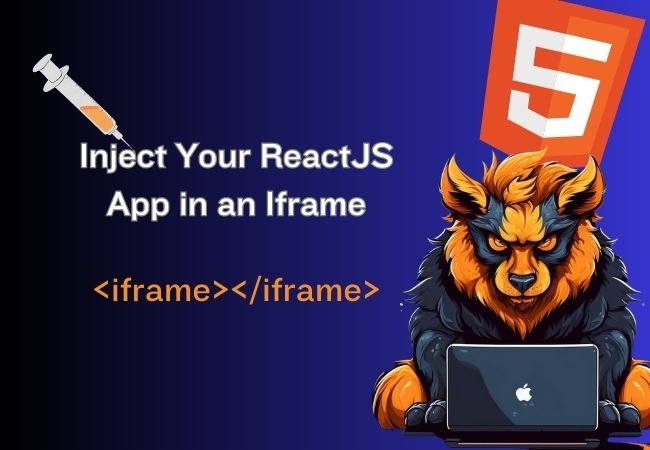Embedding your ReactJS app in an iframe is a great way to share your app with others and showcase it on other websites. It can help you reach a wider audience and increase your app’s visibility. In this blog post, we will explain what iframes are, why you might want to use them, and how to embed your ReactJS app in an iframe.
Contents
What is an iframe?
An iframe, or inline frame, is an HTML element that allows you to embed another HTML document inside your web page. This means that you can display content from another website, or even from your own website, within a specific area of your page. Iframes are commonly used for displaying ads, videos, and maps.
There are several reasons why you might want to embed your ReactJS app in an iframe and share it on other websites:
- Increased visibility: Embedding your app in an iframe allows you to showcase it on other websites, which can help you reach a wider audience and increase your app’s visibility.
- Easy integration: By providing an iframe code snippet, you can make it easy for other website owners to integrate your app into their website.
- Controlled environment: By embedding your app in an iframe, you can control the environment in which it is displayed. This can help you ensure that your app is displayed correctly and prevent conflicts with other scripts or styles on the hosting website.
How to open your React application in iframe?
If you’re looking to embed your ReactJS application into an iframe in another website, you’re in luck! It’s actually quite easy to do with a few simple steps.
First, make sure that your React application is running on localhost:3000.
Next, in your HTML project, create an iframe element in the HTML file where you want to display the React application. Set the src attribute of the iframe to http://localhost:3000 and specify the width and height of the iframe.
<iframe id="my-iframe" src="http://localhost:3000" width="800" height="600"</iframe>
However, when you try to access the React application from the iframe, you may run into a CORS (Cross-Origin Resource Sharing) issue. This means that the browser blocks the iframe from accessing content from a different origin (in this case, localhost:3000).
To fix this, you will need to add a CORS header to your React application. To do this, you can use the Express library to set up a server that adds the necessary headers.
Add the following code to the beginning of your App.js file:
import express from 'express';
const app = express();
app.use(function(req, res, next) {
res.header('Access-Control-Allow-Origin', '*');
res.header('Access-Control-Allow-Headers', 'Origin, X-Requested-With, Content-Type, Accept');
next();
});
This code sets up an Express server with CORS headers that allows any domain to access the content of your React application.
Next, add the following line of code to the end of your App.js file to start the server:
app.listen(3001);
This starts the server on port 3001, which will allow the HTML file to access your React application.
Finally, run your React application using the command npm start.
How to Pass and Parse Parameters in the Iframe SRC URL in Your ReactJS App?
Sometimes you may want to pass parameters to your ReactJS app through the iframe src attribute. For example, you may want to pass user information, page settings, or other data to your app. In this tutorial, we’ll show you how to pass and parse parameters in the src attribute of an iframe in your ReactJS app.
Pass parameters in the iframe src URL
To pass parameters in the src attribute of an iframe, you can include them in the URL query string. For example:
<iframe src="http://localhost:3000/?param1=value1&amp;amp;amp;param2=value2"</iframe>
In this example, we passed two parameters named param1 and param2 with values value1 and value2, respectively. You can include as many parameters as you need, separated by the & character.
Parse parameters in your ReactJS app
To parse the parameters passed in the src attribute of an iframe, you can use the URLSearchParams object. The URLSearchParams object allows you to extract the query string parameters from the window.location.href property.
Here’s an example code snippet to parse the parameters in your ReactJS app:
import React, { useEffect } from 'react';
function App() {
useEffect(() => {
const searchParams = new URLSearchParams(window.location.href);
const param1 = searchParams.get('param1');
const param2 = searchParams.get('param2');
// Do something with the parsed parameters
console.log(param1, param2);
}, []);
return (
<div className="App">;
{/* your React application code */}
/>
);
}
export default App;
In this code, we used the URLSearchParams object to parse the query string parameters from the window.location.href property. We then stored the parsed parameters in the param1 and param2 variables.
You can use these variables in your ReactJS app to display the passed data or to modify the behavior of your app based on the parameters.
Passing and parsing parameters in the src attribute of an iframe is a powerful technique for sharing your ReactJS app on other websites. By including parameters in the URL query string and parsing them in your app using the URLSearchParams object, you can create dynamic, data-driven apps that can be easily embedded in other websites.
Now you should be able to open the HTML file in your web browser and see the React application displayed in the iframe. Keep in mind that if your React application has any authentication or authorization requirements, you will need to make sure that the HTML file has the necessary permissions to access your React application.
And that’s it! With just a few simple steps, you can easily embed your ReactJS application in an iframe and share it on other websites.





0 Comments